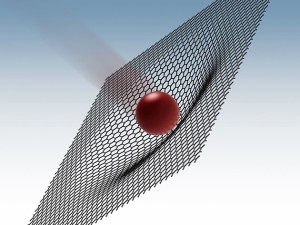
The ballistic test shows that graphene is excellent at both absorbing and spreading the energy of an impact.
Credit: Jae-Hwang Lee
We’ve been talking a lot about graphene – from its potential in energy storage to its ability to improve and revolutionize personal electronic devices, this material seems to be everywhere. Now, engineers out of the University of Massachusetts believe it could help save lives.
Engineers developed a mock-up of multilayered graphene body armor and tested it in a miniature shooting range. The results suggest that graphene may be able to absorb 10 times the amount of energy that its steel competitor can before failing.
This from the Royal Society of Chemistry’s Chemistry World:
The bullet was propelled into stacked graphene sheets at supersonic speeds of up to 2000mph by the gases produced by laser pulses rapidly evaporating a gold film. The team calculated the energy difference of the bullet before and after to determine the energy absorbed.
In the test, graphene was able to absorb up to 0.92MJ/kg of ballistic energy in comparison to steel targets, which only absorbed 0.08MJ/kg at the same speed.
While the pure strength of graphene has been tested and proven before, it has not until now come under the extreme conditions of high-speed ballistics.
According to Chemistry World, grapehen’s success in this experiment boils down to both its high stiffness and low density. Because of these two things – sound, stress and energy can travel though the material faster. With this, energy is spread at a higher speed across the area, which allows the material to support the load and reduce the damaging effect of the bullet.
Want to read more of the latest research in graphene? Check out the breakthroughs our scientists are making in our Digital Library. While you’re there, sign up for our free e-Alerts so you don’t miss the latest research.

